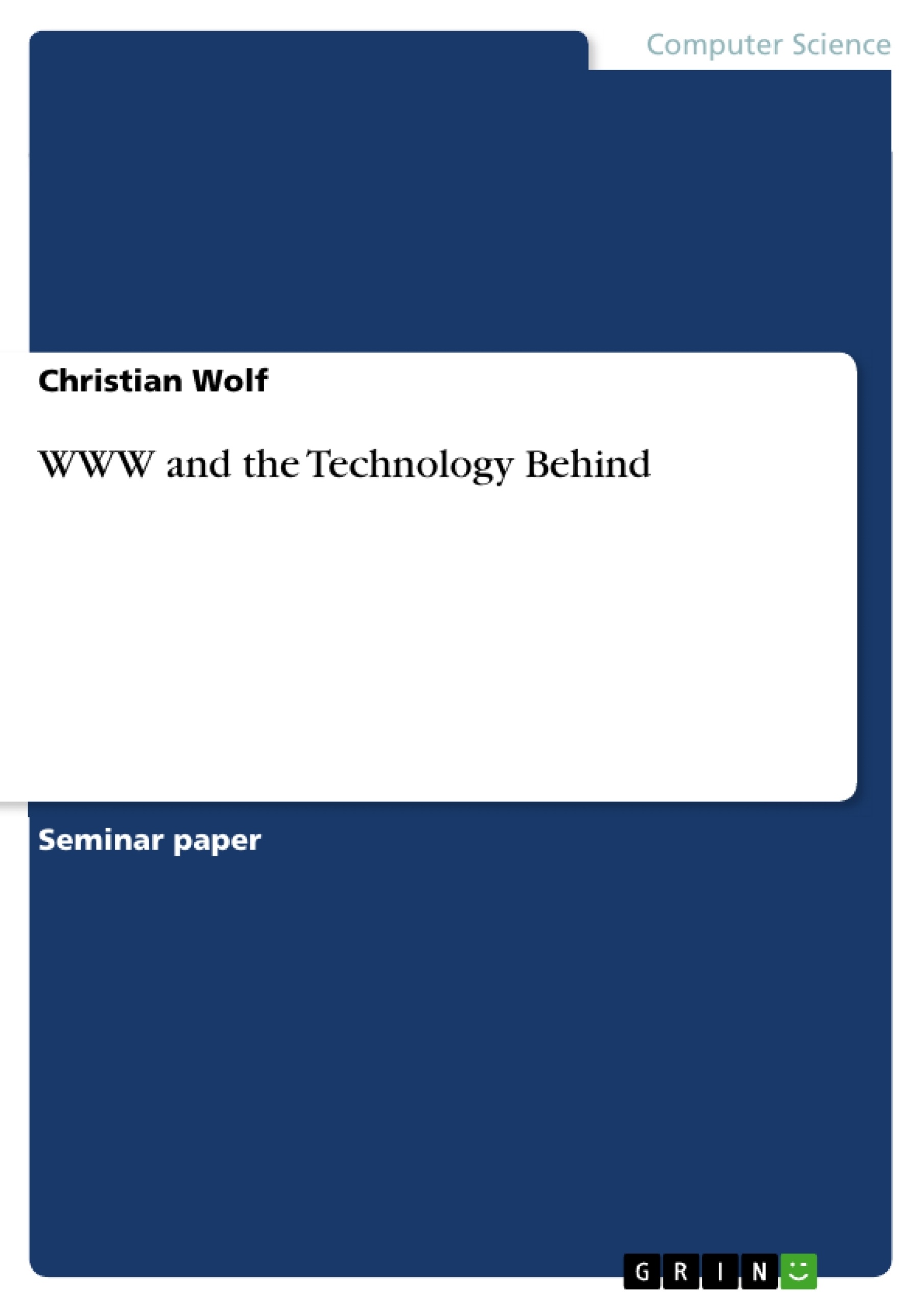With the middle of the 1990s an army of acronyms started to conquer the world. Any combination of three or four letters seemed to have a high tech meaning; HTTP, FTP, ASP, PHP, SMTP, POP and many more. One was, and still is, virtually everywhere to be found: WWW. After some time, most people realized that they all had something to do with a network of computers spanning the globe, the Internet. But what are they really about and how does the Internet work, anyway?
It is the purpose of this paper to shed some light on the meaning of some of these acronyms. It is an introduction to the technologies that can be seen as the technological basis of the Internet and its most prominent application, the Worldwide Web a.k.a. the web or WWW. Priority will be given to technologies that are widely used and are considered to be of importance for the future development of the web. Starting with the protocols that govern information exchange over the internet, namely the Hypertext Transfer Protocol, the Simple Mail Transfer Protocol, and the Post Office Protocol, this paper will continue by giving a short introduction to current additions to HTML, “the web’s language”. A description of basic HTML is left out deliberately, as very profound and complete literature on this subject is already available in great numbers. A section on ways to dynamically create web pages will be ultimately followed by an introduction to internet security issues and available technologies for data protection, namely SSL, HTTPS, S-HTTP, and IPsec.
Inhaltsverzeichnis (Table of Contents)
- Introduction.
- 1. The Hypertext Transfer Protocol - HTTP
- 1.1 HTTP - a short history
- 1.2 Functionality
- 1.3 Messages in HTTP.
- 1.4 Fetching/sending information in HTTP
- 1.5 Error handling.......
- 1.6 HTTP proxies
- 1.7 Content Negotiation.……………….………….
- 1.8 Authentication…........
- 1.9 Domain Name System - DNS..
- 2. Internet E-mail….......
- 2.1 Simple Mail Transfer Protocol (SMTP).
- 2.2 Post Office Protocol (POP).......
- 2.3 Internet Message Access Protocol - IMAP ..
- 2.4 MIME
- 3. Presentation - CSS, DHTML, XHTML .......
- 3.1 Cascading Style Sheets - CSS.....
- 3.2 Dynamic HTML - DHTML
- 3.3 XHTML ..
- 3.4 The Relationship between HTML and its complements.
- 4. Extensible Markup Language - XML
- 4.1 Functionality
- 4.2 The goals of XML
- 4.3 XML applications ......
- 4.4 Document Type Definition.
- 4.5 XML style sheets.
- 4.6 XML parser...
- 5. PHP as an Example of a Scripting Language ....
- 5.1 PHP-a short history
- 5.2 What possibilities does PHP offer? Why choose PHP?
- 5.3 Functionality
- 5.4 Environments
- 5.5 Alternatives to PHP
- 6. Security
- 6.1 Secure Socket Layer - SSL
- 6.2 HTTP via SSL – HTTPS..
- 6.3 Secure HTTP – S-HTTP.
- 6.4 A Possible Alternative - IPsec .
- Appendix - PHP tasks ....
- References and Further Reading.......
Zielsetzung und Themenschwerpunkte (Objectives and Key Themes)
This paper aims to provide an introduction to the technologies that form the technological basis of the Internet and its most prominent application, the World Wide Web (WWW). The focus is on widely used technologies considered important for the future development of the web.
- The fundamental protocols that govern information exchange over the internet, including HTTP, SMTP, and POP.
- The evolution and functionality of the Hypertext Transfer Protocol (HTTP) and its different versions.
- Key technologies in web presentation, such as CSS, DHTML, and XHTML.
- The role of Extensible Markup Language (XML) and its applications.
- An overview of server-side scripting languages, using PHP as an example, and their role in web development.
Zusammenfassung der Kapitel (Chapter Summaries)
- Introduction: The paper introduces the concept of the World Wide Web and its underlying technologies. It highlights the importance of understanding these technologies for the development and understanding of the internet.
- 1. The Hypertext Transfer Protocol - HTTP: This chapter explores the history, functionality, and different versions of HTTP. It covers key aspects such as message formats, request/response interactions, and error handling.
- 2. Internet E-mail: This chapter delves into the technologies involved in internet email communication. It focuses on protocols like SMTP, POP, and IMAP, as well as MIME for handling different email formats.
- 3. Presentation - CSS, DHTML, XHTML: This chapter discusses the technologies that enhance the visual presentation of web pages. It covers key concepts like Cascading Style Sheets (CSS), Dynamic HTML (DHTML), and XHTML.
- 4. Extensible Markup Language - XML: This chapter introduces XML, its functionality, goals, and various applications. It also discusses XML related concepts like Document Type Definition (DTD), XML style sheets, and XML parsers.
- 5. PHP as an Example of a Scripting Language: This chapter explores the capabilities of PHP, its history, and reasons for its popularity. It outlines its functionality, different environments, and alternative scripting languages.
Schlüsselwörter (Keywords)
The primary keywords and focus topics of this text include: Hypertext Transfer Protocol (HTTP), Simple Mail Transfer Protocol (SMTP), Post Office Protocol (POP), Internet Message Access Protocol (IMAP), MIME, Cascading Style Sheets (CSS), Dynamic HTML (DHTML), XHTML, Extensible Markup Language (XML), PHP, security, Secure Socket Layer (SSL), HTTPS, S-HTTP, IPsec. This paper delves into these technologies, highlighting their roles in shaping the internet and World Wide Web.
- Quote paper
- Christian Wolf (Author), 2002, WWW and the Technology Behind, Munich, GRIN Verlag, https://www.hausarbeiten.de/document/4644


